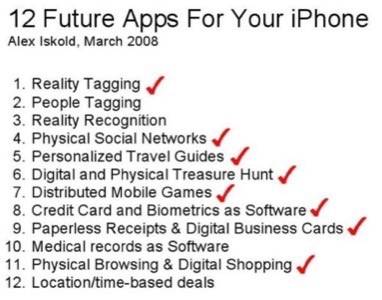During his keynote presentation at the ReadWriteWeb Mobile Summit today, our founder and editor Richard MacManus examined the trends and issues around mobile that we have been tracking here on RWW. Among the topics covered in today’s keynote were geo-location, mobile commerce, cloud computing, privacy, and the Internet of Things. MacManus’ discussion also touched upon the advantages and disadvantages of mobile websites and native apps.


Browser-Based vs. Native Apps
Looking at the market for mobile phones, it becomes clear that touch screen-enabled devices are now becoming the norm. According to the latest data from Taptu, there are currently over 326,000 mobile sites on the Web that have been optimized for touch. In addition, there are over 185,000 iPhone apps in Apple App Store and 27,000 Android apps in the Android Market, most of which are connected to the Internet. As mobile browsers have become more capable, though, it is clear that developers can also create very compelling mobile applications in the browser. One of the examples MacManus brought up during the keynote is the HTML5 location-based social network Burbn. As MacManus also noted, even though we tend to talk about native apps a lot, mobile touch websites will be a major trend in the near future, especially for e-commerce sites.

Looking at an older RWW story by Alex Iskold from 2008 about 12 potential apps for the iPhone, MacManus noted that we now have access to 8 out of these 12 apps that – not too long ago – still sounded futuristic. As an example for these apps that have now become reality, MacManus highlighted Recognizr – an augmented reality app that recognizes faces and displays people’s social media streams next to their faces.

Location, Sensors and the Internet of Things
Another mobile trend for 2010 is also clearly geo-location and location as a platform. While current use cases like apps that show you nearby restaurants, mobile ads, and local news and events are already very compelling, MacManus also noted that being able to combine location data with sensor data could easily spark another round of exciting innovations for mobile apps.
Already, as Richard stressed, there are over 430 million phones with accelerometers, compasses, gyroscopes and pressure sensors in use today. Some analysts predict that this number will rise to over 2.2 billion by 2014.
The Internet of Things, too, is another trend we are tracking closely here at RWW. Using your phone as a barcode reader or as an RFID tag is already becoming quite common in some countries, though in the future, MacManus expects that we will also see wider use of the sensors we already have in our phones.

Emerging Standards
Among the trends around mobile development that we are currently tracking, MacManus noted the emerging wireless standards like DASH7, NFC, ZigBee and – of course – WiMax and 4G. Mobile sensors, especially, are one of the topics that we are very excited about here at RWW.
Augmented Reality
MacManus also talked about augmented reality, which has really come to the forefront over the last few months. Over 150 of the world’s largest companies (by revenue) like Toyota, Boeing, General Motors and Microsoft have already employed AR in their products and marketing campaigns. In total, more than 1,000 AR campaigns were kicked-off in 2009. Some of the examples for augmented reality apps noted in MacManus’ keynote were Wikitude and Junaio iPhone app that taps into the BART API and displays data about local transit conditions in the Bay area.

















